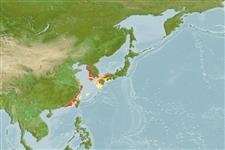Common names from other countries
Environment: milieu / climate zone / depth range / distribution range
বাস্তুসংস্থান
; স্বাদু পানি; ঈষৎ লোনা ; গভীরতার পরিসীমা 0 - 25 m (Ref. 81172). Temperate; 5°C - 27°C (Ref. 8003); 44°N - 21°N, 112°E - 135°E
Northwest Pacific: Native from Valdivostok Russia, to the west coast of North Korea south to Hong Kong, China. Introduced to central and western Europe.
Length at first maturity / আকৃতি / ওজন / Age
Maturity: Lm ? range ? - ? cm Max length : 7.5 cm CW পুরুষ/ লিঙ্গ অনিধর্ারিত ; (Ref. 3159)
Catadromous (Ref. 101972). Maximum depth from Ref. 104445. Euryhaline (Ref. 115548). Catadromous (Ref. 115520, 115522), spending most of its life growing to maturity in freshwater (Ref. 115522). Found in coastal rivers and estuaries. It needs brackish or saltwater to reproduce (Ref. 8778). Downstream migration of adults occurs worldwide (Ref. 115548). From sublittoral sediment and surface running water (Ref. 104191). Adults are found in fresh, brackish and salt waters; oviparous females are typically in greatest number in saltwater (Ref. 115548). Has high affinity to burrow. Juveniles are known to form burrows in soft-sediment banks between high and low tide lines upon migration into brackish channels and creeks. In general, small juveniles construct and inhabit these burrows (Ref. 104191). Larger crabs occasionally burrow in softer substrate of freshwater stream banks. When abundance increases, burrows can become very dense, causing bank weakening, erosion, loss of bank vegetation, and bank collapse (Ref. 115547). In Germany, burrows reached 50 cm deep, which caused considerable damage (Ref. 115521). Predominantly omnivorous; however, it exhibits plasticity in its diet (i.e., feeding habits may shift throughout the cycle). Likely to scavenge and feed on detritus (Ref. 104191). Larvae feed on phytoplankton; newly settled juveniles feed on aquatic plants (Ref. 115548). Shifts to a more carnivorous diet as it ages, eating shrimp and other benthic invertebrates. Also reported to feed on fish captured in fishing nets (Ref. 104191). Opportunistic feeder (Ref. 115548). Feeds on periphytic algae, terrestrial plants, detritus, sand, copepods and chironomid larvae (Ref. 107018). Carries a lung fluke trematode parasite Paragonimus westermani that infects humans (Ref. 115522).
Life cycle and mating behavior
পরিপক্কতা | প্রজনন | ডিম ছাড়া | ডিমসমূহ | ডিম্বধারন ক্ষমতা | শুককীট
Life cycle: Eggs are carried until hatched and the adults die afterwards. The larvae undergo five zoeal stages. Juveniles migrate from the estuary to the freshwater to develop into adults. Adults migrate downstream, mating occurs in saline water.
Ray, G.L. 2005. (Ref. 3159)
IUCN Red List Status (Ref. 130435)
CITES status (Ref. 108899)
Not Evaluated
Not Evaluated
Human uses
মৎস্য: বাণিজ্যিক
FAO - এ্যাকুয়াকালচার (জলজ পালন) : উৎপাদন , species profile; মৎস্য: landings, species profile | FishSource | আমাদের চতুর্পাশ্বের সাগর
হাতিয়ার
ইন্টারনেট সুত্র
Estimates based on models
Preferred temperature
(Ref.
115969): 14.1 - 23.2, mean 20 (based on 109 cells).
Vulnerability
Low vulnerability (10 of 100).
Price category
Unknown.
